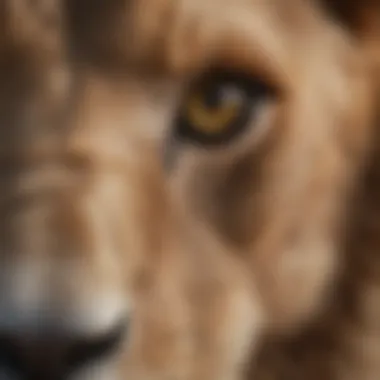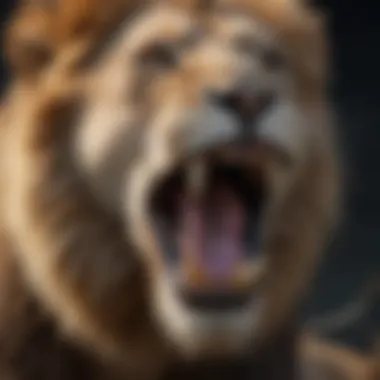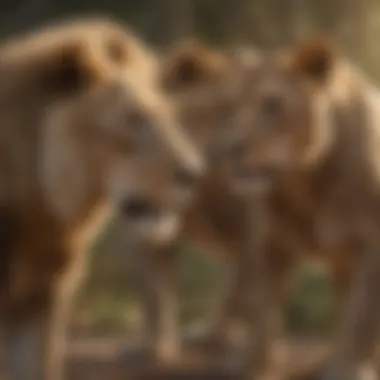Exploring the Physical Adaptations of Lions in Nature


Prologue
Lions, often revered as the kings of the jungle, possess a distinct set of physical adaptations that contribute not only to their survival but also to their role as apex predators in the ecosystem. This section serves as an introduction to the incredible qualities exhibited by these magnificent beings.
Lions are primarily found in Africa, with a small population in India, specifically in the Gir Forest. Their unique adaptations manifest in various aspects of their physiology and behaviors. Understanding these traits ensures a deeper appreciation of their place in nature and the intricacies of their social structure.
Animal Species Profile
Foreword to the animal species
The lion (Panthera leo) is a social and territorial big cat known for living in prides. Each pride typically consists of several related females, their offspring, and a few males. This social structure allows them to work together not only for hunting but also for the protection of their territory. Over time, the lion has adapted to become one of the most successful predators in varying environments.
Physical characteristics and appearance
One cannot discuss the lion without mentioning its remarkable features. Adult males are characterized by their flowing manes, which serve various purposes, including attracting females and intimidating rivals. In contrast, females are smaller and lack manes; their lighter coloration helps in hunting. The strength and muscular build of both sexes are designed for short bursts of high-speed chases, essential for hunting.
Their acute senses further enhance their prowess. Lions have highly developed eyesight, especially at night, allowing them to detect prey with precision in low light. Their physically strong limbs and sharp claws make them formidable when they pounce.
Natural habitat and distribution
Lions inhabit a range of environments from grasslands to savannas and woodlands, generally favoring areas with sufficient cover and easy access to prey. Natural distribution has further declined due to habitat loss and human interference, mainly through agricultural expansion. Preservation of their natural habitat is vital for maintaining their population levels.
Behavior and social interactions
Social structure is a key part of lion behavior. Within a pride, males exhibit dominance through displays of physical strength and vocalizations. Meanwhile, females typically manage prey acquisition and cub rearing. This division of labor speaks to their evolution as cooperative hunters. Interactions are marked by grooming and play, reinforcing bonds within the pride, which enhances their hunting effectiveness and social stability.
Conservation & Wildlife Efforts
Overview of conservation status
Despite their cultural prominence, lions face numerous threats. According to the IUCN Red List, lions are classified as vulnerable. Effective conservation efforts focus on tackling these challenges head-on to safeguard their future.
Threats to the species
Various pressures threaten lion populations, including habitat loss due to agriculture and urbanization, human-wildlife conflict, and poaching. The shrinking of their territories compromises not only their survival skills but also their social structures.
Conservation initiatives and organizations
Many organizations aim to protect these majestic creatures and their habitats. Initiatives include creating wildlife corridors, sustainable land use, and anti-poaching efforts. Organizations like the African Wildlife Foundation and Panthera have led efforts in improving conservation strategies across lion habitats.
Success stories and impact
Conservation successes include the establishment of protected areas like the Serengeti National Park, which harbors a healthy lion population. These areas not only benefit lions but also the vast biodiversity intertwined with their existence. Increased awareness leads to community involvement and tourism that support sustainable management.
Preamble to Lion Physiology
Understanding lion physiology is crucial for grasping how these magnificent creatures thrive in the wild. This section introduces elements of lion biology and emphasizes the critical link between their physical traits and ecosystem roles. Knowing the anatomy and adaptations of lions helps unveil the intricacies of their survival tactics, mating behaviors, and social interactions. It sets a foundation to appreciate their complexity as apex predators.
Evolutionary Background
The evolutionary background of lions reveals a rich tapestry of adaptation shaped by millions of years of natural selection. Lions are believed to have roamed the Earth for around 1-2 million years. Over time, their lineage split to form distinct subspecies, adapted to various environments ranging from savannas to grasslands.
This evolution is notably marked by the growth of social structures. Modern lions are one of the few big cats that display social behavior, living in prides. This adaptation may have provided advantages for hunting and protection, notably when faced with rivals like hyenas. Their historical resilience allows them to thrive despite human threats and habitat loss.
Significance of Physical Adaptations
Physical adaptations are significant because they directly influence a lion's hunting efficiency and social structure. These adaptations are not merely biological; they are keys for survival in an often harsh and competitive environment.
Key Adaptations Include:


- Musculature: Powerful muscles enable swift pursuits during hunts
- Skeletal structure: A robust skeleton supports heavy weight, crucial for their size
- Sensory Systems: Superior vision and hearing help detect prey and danger
These traits highlight how lions are finely tuned to their roles as hunters and protectors, and they also play an important part in their reproductive success. The evolutionary importance of these adaptations can not be overstated, offering insights into their behavior and ecology in various environments.
Anatomical Features of Lions
Understanding the anatomical features of lions is crucial to grasp their remarkable adaptations as apex predators. Their physical structure plays an important role in hunting, social interactions, and overall survival.
Musculature and Strength
Lions are renowned for their power and agility. Their musculature is well-developed, particularly in the forelimbs, allowing them to deliver strong swipes and grips essential for hunting. The skeletal structure supports this power with specific adaptations that facilitate movement and overall strength. The combination of muscle and bone allows lions to possess a bite force of around 650 pounds per square inch, making them capable of bringing down substantial prey.
Hunting often requires swift sprints, where they rely on the strength in their hind legs for explosive movements. This ability is crucial during coordinated attacks on large herbivores such as buffalo or wildebeests. The robust pectoral muscles allow for stability and strength when overpowering prey.
The musculature of the lion embodies both strength and elegance, propelling them as one of the most formidable predators in the wild.
Size and Weight Variations
Lions show notable size and weight variations that often depend on their region and habitat. Males typically vary in weight from 330 to 550 pounds, while females average between 260 to 400 pounds. This significant sexual dimorphism highlights the divergence between the sexes in terms of size and weight, which can have varying implications for survival activities, including hunting roles and pride dynamics.
In different environments, factors like diet and habitat can affect other physiological changes too. For instance, lions in more arid regions may develop leaner frames compared to their counterparts in lush territories where they can access ample prey. Evolutionary pressures also play a role; larger males may fight more effectively for dominance and breeding rights, while smaller, nimble females may excel in agility for hunting. Understanding these variations helps highlight how lions adapt physiologically to their environments, ensuring their survival and fostering social structures among prides.
Sensory Adaptations
Sensory adaptations are crucial for Lions, as these capabilities intermingle with their predatory nature and social dynamics. The primary senses—their exceptional vision, keen hearing, and acute sense of smell—play significant roles in every aspect of their lives. These adaptations enable lions not only to hunt effectively but also to maintain social interactions within their prides and navigate their environments skillfully.
Vision
Lions possess remarkable visual acuity which aids them in hunting and foraging. Their eyes are well-equipped for low-light conditions, allowing them to be active during twilight and nighttime hours, often referred to as crepuscular animals. The tapetum lucidum, a reflective layer behind their retinas, enhances their ability to see in minimal light. This adaptation maximizes their hunting efficiency, enabling predators to spot potential prey lurking even in dim lighting.
The structure of lion eyes is particularly beneficial when extending hunting terrains, as prey like zebras and antelopes often behave based on daylight activity. As apex predators, understanding the unique body language of their quarry and their environmental surroundings is vital.
Hearing
Another critical adaptation is the lion’s acute hearing. They can hear frequencies ranging from 50 to 60,000 Hz. Compared to humans, who can only detect sounds up to approximately 20,000 Hz, lions have an extraordinary capability to detect high-pitched sounds, facilitating communication with pride members over large distances, even in dense vegetation. This skill helps them coordinate complex hunting strategies, as sounds can indicate the movements of prey or the actions of rival prides.
Lions can also pick up cautionary sounds from gazelles or other species, further benefiting their predatory lifestyle. Their ears are capable of rotating, allowing them to pinpoint sound sources in their environment efficiently.
Smell
Lion’s sense of smell is another vital sensory adaptation. They have a highly developed olfactory system that is instrumental in marking territory and detecting potential mates. Their sense of smell aids in assessing threats and recognizing scents from fellow pride members, elements that shape their social structure. This adaptation is particularly important for communication, ensuring interactions remain strong within those dynamic group settings.
Moreover, when tracking prey, scent marking serves as not just a communication medium but also an aid in engaging hunting strategies. With their acute olfactory signatures, lions can sense movements from a significant distance, giving them the upper hand while stalking.
“Lions are often revered for their raw strength, but their complex sensory adaptations are what allow them to maintain and enhance their predatory dominance in nature.”
Understanding these sensory abilities becomes foundational when analyzing the impressive hunting and survival strategies of lions. These adaptations display evolution’s finely-tuned progression, fostering both individual and group advantages in wild habitats.
Dental and Skeletal Adaptations
The dental and skeletal adaptations of lions are central to their identity as apex predators. Their teeth and bones not only withstand the rigors of their existence but also optimize their abilities in hunting, feeding, and social interactions. Understanding these features provides insight into how lions maintain their positioning at the summit of their ecological niche.
Teeth Structure and Function
Lions possess a distinct dental formula that plays a crucial role in their survival. With strong, sharp canines that can exceed three inches in length, these teeth are designed primarily for one purpose: to grab and hold onto prey. *Teeth are not only tools for killing but also instruments for consumption.* After a successful hunt, lions often rely on their robust molars for crushing bone and tearing meat. The positioning of these teeth allows for an effective bite, creating a force sufficient to penetrate hides and break through the thick skins of their usual prey.
Furthermore, the structure of lion teeth reflects their dietary needs. Unlike herbivores, who have flat molar surfaces for grinding plants, lions possess serrated edges for slicing through flesh. This adaptation directly enhances their predatory efficiency. Condition of teeth is also significant. Damaged or worn teeth can complicate feeding and impair survival, especially for older individuals.
The importance of strong, well-maintained teeth cannot be overstated; they directly impact a lion’s ability to feed and thrive in the wild.
Claws and Paws


Lions have unique adaptations in their claws and paws that provide multiple advantages in their environment. The retractable nature of their claws ensures protection against wear while enabling the lions to maintain sharpness essential for hunting. This get advantages during a chase or when grappling with large prey, as claws can dig in and provide a firm grasp.
Each paw is padded and structured for silent movement through grassland and savanna habitats. This provides lions with a stealth advantage. When stalking prey, a lion’s padded feet facilitate almost silent approach, critical for securing a successful kill. The size and shape of the paw also aid in weight distribution, allowing lions to run and maneuver effectively when needed despite their large body size. Moreover, their approximate footprints, at eight to ten inches across, can lead to visual signs that can be interpreted by other lions and prey alike.
In summary, the coexistence of strong claws and specialized paws leads to increased efficiency in hunting while ensuring lions can excel in their roles as predators. Key elements like power, grip, and stealth play a vital part in their success as social hunters who frequently rely on coordinated specific strategies for prey capture.
Coat and Coloration
Coat and coloration play a vital role in a lion's survival strategy. These aspects not only provide a dysfunctional advantage for hunting but also contribute to social systems within lion populations. Understanding how these features function offers insight into how lions adapt effectively to their habitats while highlighting their place in the ecological niche.
Role of Fur in Camouflage
Lions possess a short, tawny fur that allows them to blend into their natural surroundings, especially during the twilight hours when they hunt. This coloration mimics the grasses and savannah they inhabit. Moreover, it helps in creating an unsettling effect while stalking prey.
Camouflage is essential for lions when approaching their prey without alerting them. The strategy often includes using shade and terrain features, like tall grasses and bushes, creatively. When needed, they adapt positioning, utilizing their coats to disappear against the environmental backdrops. Studies have indicated that their furs tend to lighten or darken with the seasons, improving adaptability. On a subtler level, even the density of their coats changes with factors like weather and geographic location.
Social Signaling Through Mane
The mane, typifying male lions, is more than mere decoration. It carries social significance, acting as a visual cue for dominance and maturity. The color and size of a lion’s mane may suggest factors such as overall health and genetic fitness to potential mates and rivals.
A lion's mane starts to grow at around one year of age and continues vast changes until maturity. Darker, fuller manes can indicate higher testosterone levels and are often linked to improved chances in mating. Showing strength and ability to defend the pride plays a crucial factor in the presence of an impressive mane.
Furthermore, the mane also contributes to protection during fights. It shields the neck region, a vital area in confrontations with other lions. This physical implication represents how social factors intermingle with physical adaptations, further allowing lions to navigate their environments successfully.
The components of coat and color in lions are intricate instruments of survival and social interaction, pivotal for sustaining their species and interaction hierarchies.
In summary, coat and coloration bring light to the physical adaptability of lions. As seen, these features give lions advantages that directly correlates with their lifestyle as apex predators. They are not just aesthetic traits, but rather vital for ensuring longevity in their environment.
Hunting and Feeding Strategies
Hunting is a critical aspect of a lion's survival. The strategies lions employ to hunt not only affect their own survival, but they also play a crucial role in the health of the entire ecosystem. Maintaining their role as apex predators allows lions to regulate prey populations, which in turn supports ecological balance in their environment.
Pack Behavior and Coordination
Lions are have a unique social structure that heavily influences their hunting techniques. As social animals, they often hunt in prides, usually consisting of several related females and a few males. This cooperation boosts their chances of a successful hunt. Each lion in the pride has a role. Some may act as lookouts while others lead the chase.
For instance, females typically do most of the hunting due to their agility and sociability. They tend to use their numbers to work as a collective unit.
- Setting Surroundings: Before initiating a hunt, cubs under the supervision of the females learn how to work with the pride.
- Diverse Strategies: Coordination involves various strategies and techniques, depending on the terrain and the type of prey they are targeting.
- Silent Communication: Lions communicate using silent signals, such as subtle movements and eye contact, emphasizing teamwork without alerting their prey.
Conclusively, the power of group hunting results in more effective kills and a higher likelihood of nutritional esteem for the entire pride.
Stalking Techniques
Stalking is an incomprehensibly vital skill for lions, allowing them to get as close to their prey as possible without being detected. Lions combine stealth monitoring their pace with strategic anticipation to approach their targets. These steps demonstrate their hunting sophistication:
- Crouching Stance: Lions often drop low to the ground to conceal themselves. This position makes them appear smaller, blending in with the surroundings.
- Approach Timing: Accurate timing is crucial. They tend to make their move when the prey is preoccupied or relaxed.
- Break Cover: Once close enough, typically around 20 to 30 meters away, lions unleash their powerful sprint.
According to studies, a successful approach can significantly impact a lion's success rate in securing a meal. This exceptional stalking capability defines lions as some of nature's most effective hunters.
**In summary, understanding hunting and feeding strategies provides insight into lions' social and physical adaptations. Mastering their coordination in packs and stalking techniques enhances their efficiency, reflecting a sophisticated level of adaptation in the wild. **
Thermoregulation Adaptations
Thermoregulation is a critical aspect of lion physiology, particularly considering their habitats in some of the hottest regions on Earth. Healthy body temperature is vital for optimal bodily functions, hunting capabilities, and overall well-being. Different adaptations have evolved to help lions maintain their body temperature within a suitable range, allowing them to thrive in fluctuating environmental conditions. Understanding these adaptations can yield insights into the unique lifestyle of lions in the wild.
Behavioral Thermoregulation
Behavioral thermoregulation includes the actions lions take to regulate their body temperature. Spending more active hours during cooler parts of the day is a common strategy. Lions tend to rest in shaded areas to escape direct sunlight, especially during the hottest months. They also seek water sources, both for hydration and cooling purposes. Moreover, by regulating their social behaviors, lions can also manage exposure times to warmth, such as folding their limbs under their bodies at rest, thus minimizing heat loss.
- Shade Seeking: Lions often prefer shaded grounds to escape intense heat, which allows them to rest and conserve energy.
- Timing Hunts: On hotter days, lions may hunt early in the morning or late in the afternoon to avoid peak temperatures.
- Group Thermoregulation: Social structure impacts their climate adaptability; as social animals, lions might cluster to stay warm during cool periods and spread out to avoid heat during warmer times.


Physiological Adaptations to Heat
Lions possess several physiological adaptations that enhance their ability to manage heat stress. Their body structure is built to conserve water and withstand heat better than many other mammals.
A confirmed adaptation is their fur structure, which although it often appears to increase heat absorption, aids in maintaining insulation against sudden temperature drops. Additionally, paw pads contain modified sweat glands to dissipate some heat, which is an essential feature for big cats.
- Efficient Kidney Function: Their kidneys are remarkably efficient at conserving water, allowing lions to stay hydrated with very little intake during prolonged periods without water.
- Breath Regulation: Faster breathing is employed to cool the body down by increasing evaporation at exacerbated times.
- Surface Blood Flow: Adjusting the blood flow to their surface allows for better temperature management; by controlling heat release, lions can keep their internal temperature down even when external temperatures rise.
Overall, these adaptations signify lions as resilient creatures adapted to survive in challenging climates. Continuously adapting their behaviors and physiology makes them not only formidable apex predators but also extraordinary survivors of climate extremes.
Reproductive Adaptations
Reproductive adaptations play a crucial role in ensuring the survival and continuation of lion populations. Understanding these adaptations enhances our knowledge of how these magnificent creatures navigate their social world and environment. Various factors come into play in lion reproduction, including sexual dimorphism and maternal care. These elements are not merely about procreation but are multidimensional, contributing to the species' overall success in the wild.
Sexual Dimorphism
Sexual dimorphism in lions is marked by distinct differences between males and females, primarily in size and appearance. Male lions, characterized by their impressive manes, are generally larger than females. This differentiation serves multiple evolutionary purposes.
- Mate Attraction: The mane is not only a fashion statement but a significant factor in attracting mates. A fuller, darker mane can indicate a lion's health and genetic quality, appealing to females.
- Territoriality: Large males with prominent manes often command respect from rivals and secure larger territories. Their formidable presence acts as a deterrent against challengers.
- Function in Breeding: While males possess physical attributes that defend their social unit, females assume unique roles during the breeding process. They often form tighter social bonds and engage in cooperative behaviors, which aids in the success of raising cubs.
Maternal Care and Cub Development
Maternal instinct in lions is critical for the survival of cubs. Lionesses invest a significant amount of energy in nurturing their young. This commitment speaks volumes about their adaptations toward raising resilient offspring. Some key aspects include:
- Nurturing Behavior: A lioness will care for her cubs for several years, feeding, grooming, and protecting them. This intense level of care supports cub survival during their most vulnerable stages.
- Hunting: Though lionesses typically assume the role of the primary hunters, bringing food to the pride, they also teach cubs essential hunting skills. This knowledge is imperative for cubs’ future success in the wild.
- Development through Play: Young lions engage in play, which is crucial for social learning and communication. It prepares them for adult life within the pride, influencing everything from conflict resolution to cooperative hunting behaviors.
"Cubs remain with their mothers and the pride until they are about two years old, learning behaviors necessary for survival in their structured social system."
These affectionate yet fierce attributes establish lions not only as apex predators but also highlight the intricate balance of their social structure and reproductive success. Insigten into lion reproductive strategies reveals the richness of adaptation that contributes to their enduring legacy in the ecosystem.
Social Structure and Group Dynamics
Lions possess a complex social structure that is crucial for their survival and efficiency as apex predators. Unlike many big cats that are solitary, lions thrive in prides, which offer numerous advantages for hunting, protection, and rearing young. Understanding the dynamics within a pride reveals key insights into the behavior and physical adaptations of lions.
Pride Formation
The formation of a pride typically involves a social group consisting of related females, along with one or more males. Pride membership is primarily female-centric, as females usually remain within their natal prides for life. Males tend to disperse upon reaching maturity, seeking to establish their own groups either alone or in coalitions with other males. These structures work to secure a familial bond that enhances cooperative hunting and resource sharing.
The advantages of pride formation are prominent. For one, hunting large prey like buffalo or zebra becomes vastly more successful in a group. Many predators relying on solitary hunting cannot take down such large prey alone. By coordinating their efforts, lions in a pride can successfully corner, ambush, and take down prey more effectively than a single lion could accomplish. Additionally, there is enhanced vigilance against threats like rival prides or predators. With many eyes scanning the environment, the chances of survival increase substantially.
The social framework of a lion pride underscores their survival; teamwork is often the edge required to thrive in often harsh landscapes.
Roles within the Pride
Within the pride, roles are not evenly distributed; each member contributes to the overall stability and success of the group. Female lions, generally the primary hunters, take on responsibilities that include hunting, nurturing cubs, and defending their territory. Based on their age and experience, they develop strategies and tactics that ensure the pride receives adequate resources.
Conversely, male lions usually serve to protect the pride from external threats. They guard against intrusions by rival males attempting to take over, which could lead to severe challenges for the existing pride cubs. Males often display strength through vocalizations or physical demonstrations, marking their territory with scent marking rather than aggressive confrontations.
The interaction within the pride showcases a high level of social cohesion and communication. Through body language, vocalizations, and grooming behaviors, a social bond strengthens between the members, fostering cooperation and reducing intra-pride conflict, which can prevent fragmentation of the group.
Finale
The conclusion section of this article delves into the essence of the physical adaptations of lions, focusing on enhacing unserstanding of these aspects for both readers and conservationists. This synthesis brings together key elements discussed prior, underscoring the monumental role these adaptations play in lions' daily lives and survival in the wild.
Summary of Adaptations
Lions possess a diverse array of physical adaptations that solidify their status as apex predators. Notable adaptations include their muscular build, which provides strength, and sensory prowess, particularly vision and hearing, crucial for hunting. Their intricate dental and skeletal structures enable effective feeding while their fur contributes to camouflage and social communication.
- Musculature and Strength: Powerful legs that assist in sprinting and capturing prey.
- Sensory Abilities: Exceptional night vision and acute hearing.
- Dental Structure: Sharp canines mean effective utilization of their natural hunting instincts.
- Social Features: Males develop manes, serving both as protection and as displays during social interactions.
These characteristics together facilitate successful hunting and thriving social structures, ultimately enhancing their evolutionary fitness.
Implications for Conservation
The understanding of lion physical adaptations bears significant implications for conservation efforts. comprehending how these adaptations work helps identify what would disrupt their natural habitats and life cycles. With declining populations due to habitat loss and human activities, conservation programs can be tailored to protect essential environments lions depend on, thus ensuring their continuative survival.
- Protecting Natural Habitats: Maintaining ecosystems that provide food and shelter for lions.
- Enforcing Anti-Poaching Measures: Strengthening laws and regulations against hunting lions, protecting their population numbers.
- Education and Awareness: Teaching communities about the importance of lions in ecosystems fosters shared responsibility and involvement in conservation efforts.







